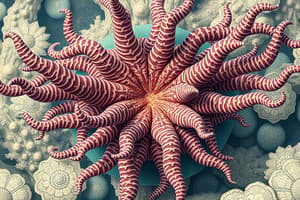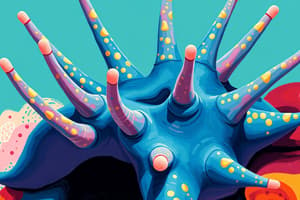Podcast
Questions and Answers
Which characteristic is unique to Echinodermata?
Which characteristic is unique to Echinodermata?
- Closed circulatory system
- Water-vascular system (correct)
- Dorsal hollow nerve cord
- Segmentation
What type of symmetry do adult Echinodermata exhibit?
What type of symmetry do adult Echinodermata exhibit?
- Asymmetrical
- Spherical
- Bilateral
- Radial (correct)
What is the circulatory system type in Chordata?
What is the circulatory system type in Chordata?
- No circulatory system
- Open with multiple chambers
- Open with a single chamber
- Closed with two or more chambers (correct)
Which system is absent in Echinodermata?
Which system is absent in Echinodermata?
Which of the following is characteristic of both Echinodermata and Chordata?
Which of the following is characteristic of both Echinodermata and Chordata?
Which feature is commonly found in the subphylum Vertebrata under Chordata?
Which feature is commonly found in the subphylum Vertebrata under Chordata?
In Echinodermata, what type of reproduction is most common?
In Echinodermata, what type of reproduction is most common?
Which of the following characteristics can sometimes be lost in adult Chordata?
Which of the following characteristics can sometimes be lost in adult Chordata?
Flashcards
Echinodermata
Echinodermata
A group of marine animals including sea stars, brittle stars, sea lilies, and sea cucumbers, characterized by radial symmetry in adults and bilateral symmetry in larvae.
Chordata
Chordata
A group of animals including tunicates, lancelets, and vertebrates, characterized by the presence of a notochord, dorsal hollow nerve cord, pharyngeal pouches, and a muscular post-anal tail.
Notochord
Notochord
A flexible rod-like structure that provides support and is found in all chordates at some stage of development.
Dorsal Hollow Nerve Cord
Dorsal Hollow Nerve Cord
Signup and view all the flashcards
Pharyngeal Pouches
Pharyngeal Pouches
Signup and view all the flashcards
Post-anal Tail
Post-anal Tail
Signup and view all the flashcards
Vertebrata
Vertebrata
Signup and view all the flashcards
Vertebral Column
Vertebral Column
Signup and view all the flashcards
Study Notes
Echinodermata
- Marine animals, usually slow-moving
- 6 classes, mostly carnivores, some filter-feeders
- Radial symmetry in adults, bilateral in larvae
- External fertilization
- Simple brain, nerve ring, with nerves and sense organs
- Complete digestive system, extracellular digestion
- Open circulatory system, reduced 1-chambered heart
- No excretory system
- Coelom present
- Endoskeleton, with calcium (reduced in sea cucumbers)
- No segmentation
Chordata
- 15 classes, 52,000 living species
- Notochord, dorsal hollow nerve cord, pharyngeal pouches (gill slits), and a muscular post-anal tail
- Three subphyla
- Mostly in Vertebrata subphylum
- Bilateral symmetry
- Sexual reproduction, usually separate sexes
- External or internal fertilization
- Brain with dorsal hollow nerve cord and ganglia, sense organs
- Complete digestive system
- Closed circulatory system, heart with 2 or more chambers
- Respiratory system, gills or lungs
- Excretory system, nephridia
- Coelom present
- Notochord (sometimes lost in adult), endoskeleton (sometimes with calcium)
- Muscular, post-anal tail (sometimes lost in adult)
- Usually with paired appendages
- Segmentation reduced or absent
Studying That Suits You
Use AI to generate personalized quizzes and flashcards to suit your learning preferences.
Description
Explore the fascinating world of Echinodermata and Chordata with this quiz. Learn about their unique structures, reproductive methods, and anatomical features. Test your knowledge on their classes, characteristics, and differences through this engaging assessment.




